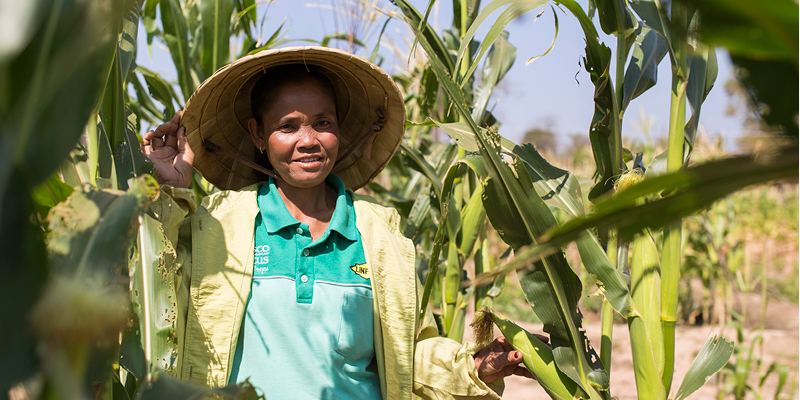Reforming crop breeding systems to keep pace with climate change
Climate change is projected to pose considerable challenges for agriculture and food security around the world. In work published in Summer 2016, world-leading plant scientists, plant breeders, crop modellers and climate modellers have come together to determine how the crop breeding can contribute to global food security in the face of increasing demand and future climate change.

Ms Lampai, head of Women’s Union and leader of the food processing group in Pailom Village in Savannakhet Province, Laos, in the community garden, where she helps test different agricultural interventions as part of a climate-smart village (picture by CUSO international via CCAFS)
It takes anywhere between ten and thirty years to breed a new crop variety and have it adopted by farmers. The rate at which temperatures are increasing across the tropics means that by the time the crop is in the field it is being grown above the temperatures that it was developed in. Unless immediate action is taken to improve crop breeding systems, yields will begin to fall within the next decade. Leeds research has focussed on maize in Africa, but the underlying processes affect crops across the tropics.
Options for ensuring that crops can be developed and delivered to the field more quickly range from hi-tech solutions such as biochemical screening techniques to more socially-centred measures such as improving government policy on breeding trials and farmers’ access to markets. The efficacy of these options is limited by resources and by social and political structures. The research team is already involved in active testing of new agricultural technologies around the globe (see photo).
By looking at a range of data on farming, regulatory policy, markets and technologies the team developed average, best and worst case scenarios for reform of breeding systems. Only the most optimistic assessment showed crops staying matched to future temperatures; and even that scenario fails to keep up if greenhouse gas emissions continue at current rates. One interesting avenue for future research is the use of global climate models to determine target temperatures for use in greenhouses. Crops are then bred in these greenhouses at the temperatures expected to occur when they reach the farmers. The challenge here is in knowing what future emissions will be and ensuring that climate models can produce accurate enough information on future temperatures based on those emissions.
Key messages:
- The process of breeding new varieties and getting them into farmers’ fields needs to speed up in order to keep up with climate change.
- The social and political structures involved in seed development and delivery are an important bottleneck requiring urgent attention.
- Climate models can be used to target breeding strategies.
Overview by Andy Challinor, Professor of Climate Impacts.
Research paper: Current warming will reduced yields unless maize breeding and seed systems adapt immediately, Nature Climate Change, 6, p. 954–958, 2016.
